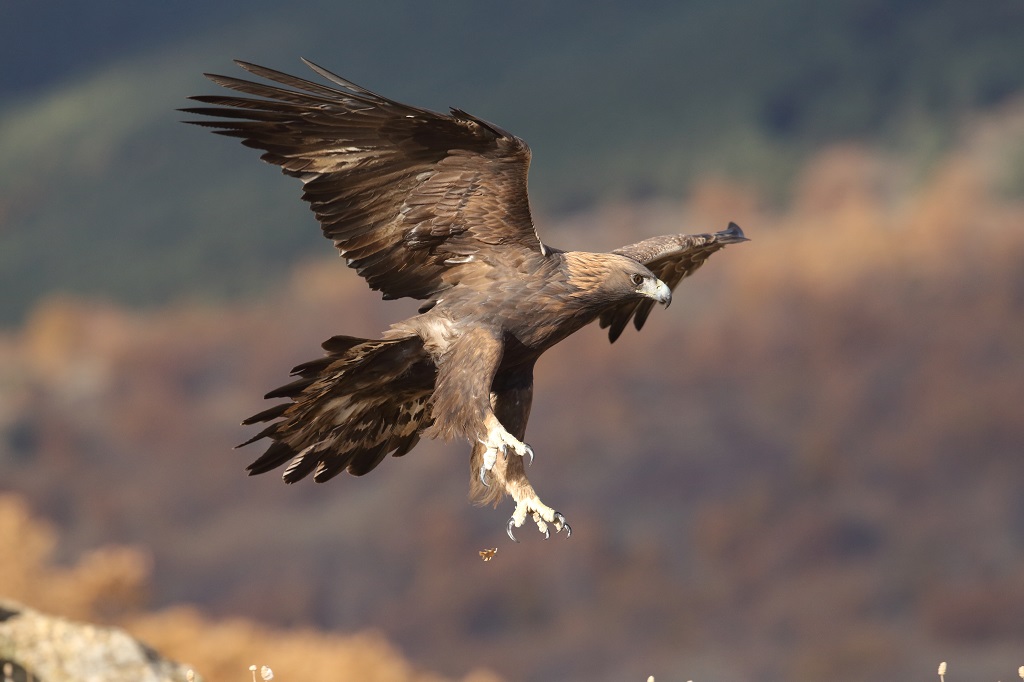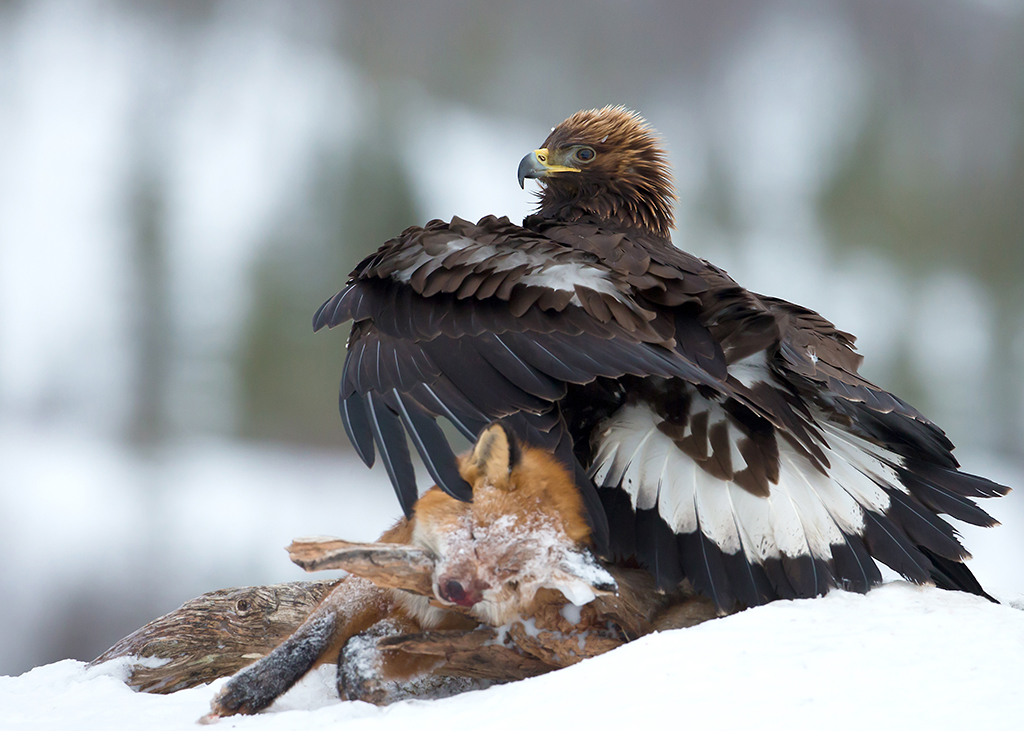‘The whole air is a thoroughfare for the eagle.’
I thought of these words of Euripides as I sat on the rocky shore, fringed by ancient oak woods, and watched a pair of golden eagles dance in the sky high above.
I had been studying one of them as it sat silhouetted and motionless on a vertiginous crag. I waited, watching it through binoculars, as oystercatcher and curlew cries were punctuated by the shrill twitterings of a rock pipit. A seal stuck its dark glossy head from the navy blue sea and snorted as it swam idly by.
When I turned back to the crag my eagle had vanished. But then suddenly two appeared in the air together and drifted out over the Sound of Mull. There, in a vast auditorium of blues, greys and greens, speckled with bronze patches of bracken, I witnessed a display as dramatic as anything the Red Arrows could manage.
The eagles dived and cruised on outstretched wings, rising and falling, extending their vast talons like landing gear. They tumbled in the air, occasionally catching each other in a brief embrace before separating and rising high again, then cascading like thunderbolts, huge wings folded back to perfect each manoeuvre.
Then, as a dense curtain of sleet moved in from somewhere off Coll, the duo vanished over the hill as if they had never been there, leaving just the memory of their perfection behind. The sight of eagles soaring through the skies is one I have relished since childhood. I have watched eagles on their eyries in many places, spied them when out stalking, seen them from above my home in Perthshire. On occasions I’ve even had them as wildlife casualties.
Many people claim that their first sighting of the creature is life changing, yet the eagle is still up against it. And their struggle for survival is entirely a result of human activity.

A golden eagle in flight
A true Highlander was once considered an unworthy sportsman until he had shot the three monarchs – a royal stag of the earth, the wild swan of the water, and the eagle of the air – and all with bow and arrow. Eagle feathers were prized, with their primary feathers worn by Highland chiefs as a mark of rank (three were, and often still are, worn in the bonnet of a chieftain; a gentleman was entitled to a single plume). Eagle feathers were used as the fl etchings for arrows, with the best thought to come from the golden eagles of Loch Treig in Lochaber.
One cannot talk of the golden eagle without mention of that great kilted naturalist Seton Gordon (1886-1977), whose ground-breaking observations spawned a whole new era of eagle watching. Days with the Golden Eagle and his other natural history books were responsible for changing attitudes towards a bird that had been persecuted for centuries.
Gordon was an ambassador for Scotland’s fauna, arguing passionately that it was preferable to view wildlife with a naturalist’s eye rather than down the barrel of a gun. He and his wife Audrey campaigned against the slaughter of predators of all hues and successfully pioneered a new approach that eventually led to today’s near idolisation of eagles.
Though fairly widespread in the north and west, the golden eagle remains uncommon. It appears to be thriving in the Western Isles, with strongholds in Harris, Lewis, Rum and Mull. Concerns were initially raised that burgeoning sea eagle numbers would pose a threat to golden eagles, but the two appear to co-exist peacefully in a state of armed neutrality.
In order to rear young, golden eagles require a large home range with abundant prey. Eyrie locations vary from cliff ledge to tree nest, with each pair making several and alternating every breeding season.

Golden eagles have eclectic tastes, and carrion is also an important part of their diet – I’ve seen birds gorging until they can barely lift off; they frequently feast on dead sheep, and I once found a bird tearing at a dead fox in a snare. One falconer friend had an eagle that was a notorious cat killer, devouring many of the moggies in his area. There are accounts of eagles riding on the backs of hinds or calves, talons deeply embedded into the fl esh as they drive the hapless creature over a cliff edge. I haven’t witnessed this, but I have seen them harrying calves towards a precipice.
For all that we revere eagles, however, nests are still robbed and they and other birds of prey are still illegally persecuted.
So the South of Scotland Golden Eagle Project, supported by SNH, Buccleuch Estates, Scottish Land & Estates and the RSPB, should be a positive step. The plan is to relocate young eagles from north-west Scotland and re-establish them in areas where eagles previously thrived. There are four pairs in the Borders just now, a region that scientists believe could support up to 16 pairs.
So why do I have a heavy heart? One reason is because the habitat has changed out of all recognition as a result of vast forestry planting schemes and a growing outdoor pursuits indus try. There is more disturbance in almost every wild corner, something that has proved disastrous to breeding eagles elsewhere.
Wetter springs have led to brood failure elsewhere, and the Borders has exceedingly high rainfall. The spread of wind farms is another obstacle, as is the fact that many of the best breeding sites for golden eagles are on prime grouse moors.
Major outbreaks of myxomatosis have meant that rabbit numbers are well down, while the current cull of mountain hares (due to tick problems) has seen their numbers fall drastically too. And if rabbits and hares are scarce, the eagles will inevitably hunt grouse. Landowners so far are supporting this project, but I wonder what they will think when they see grouse scatter in panic as the shadow of an eagle passes over them.
And if these relocated eagles successfully breed, where will their young go? If the pull is north, they will have to negotiate the Central Belt, an area bristling with pylons that will electrocute them, heavy traffic that will run them over, and a lack of food and habitat.
Perhaps I am being overly pessimistic, but I hope that golden eagles will soon be a regular sight in southern Scotland.
(This feature was originally published in 2015)
TAGS

